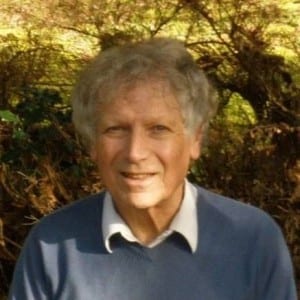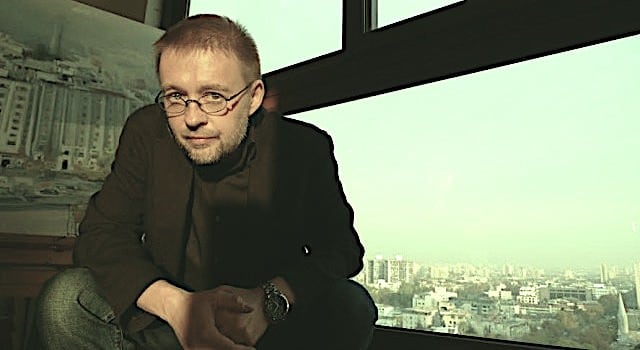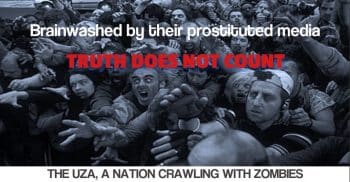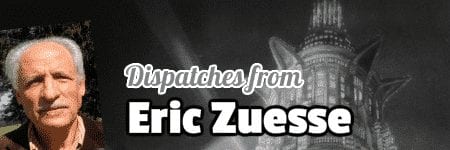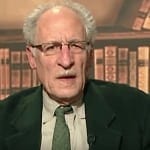|
With no attempt at precision I offer here a brief review, in (hopefully) coherent language, of the key scientific and historical steps leading to our current understanding of time considered as a physical entity. Followed by brief considerations on the influence of capitalism on the measurement of time.
I claim no scientific expertise on the subject – the review is but a brief summary of a brief history of time. A help, for me and perhaps some readers, to connect in one logical and simplified sequence the most important scientific concepts and advances, leading to the current agreed-upon view of time, and, more at large, of cosmology.
There is also another objective in striving for simplicity. As per the previous article – “The Fraud of Freud” – Freudian psychoanalysis has been largely discredited by the gross and deep dishonesty of its founder. Which included, as a tool of deception, the use of ridiculous academic language to make what is dramatically trivial appear as ‘scientific,’ thus helping to hide the morbidity, not to say the perversion (sexual and otherwise) of Freud, still considered a guru by many.
But deception never takes a long rest. Defining our current Zeitgeist is a vague and nebulous term coined by the intelligentsia as “postmodernism.” Its vagueness provides a convenient cover for such manifestations as political correctness, feminism, gender neutrality, transgenderism, furries (that is, people who dress like and pretend to be their favorite animal), miscegenation, irrelevance of sexual distinctions, racial meaninglessness (except for Jews), elimination of borders and nationalities (except Israel), unlimited immigration into the US and Europe, notably from Islamic and African countries, cultural diversity, integration and more.
And just as the film industry is a top-down imposition of official ideology, masqueraded as popular taste, postmodernism is a top-down imposition of a culture exuding from academia, and rooted in the comparatively little known socio-philosophical movement called “Cultural Marxism.” In turn, Cultural Marxism traces its roots to the 1960s and the so-called Frankfurt schools of academics.
In my view, “Cultural” and “classical” Marxism have little to do with each other. Yet, cultural Marxism at large has inspired the actual ongoing war against Western European people, nations, culture and values. A war using as weapons the tools of postmodernism, as per the list above.
We can observe a local, current, topic example and evidence of this war in the case of a class action suit, brought by a Caucasian employee against Google, who was fired after reacting with a memo objecting to the promoted and imposed-from-above company culture of “postmodernism.”
In academia, however, the postmodernists have learned to avoid the fake language of the Freudians. But the new academic postmodernist language is worse. For postmodernists attempt to blend sociology and philosophy with mathematics and physics – of which (mathematics and physics), they appear to know little other than the sound of some words.
To suggest erudition, this new brand of academics scatters and sprinkles technical terms in a context where they are totally irrelevant. And they exhibit an intoxication with words, combined with indifference to their meaning. The overall idea is to exploit the generally accepted accuracy of natural sciences, such as mathematics, to give a veneer of rigor to text that is both meaningless and incomprehensible.
In turn, the meaninglessness is intended as evidence of profound thought. Which would be almost amusing, except for the students who waste their money to acquire an “education.” Education, in the instance, based on charlatanism, hiding behind the mask of academic prestige and sustained by the students’ money that keeps up that prestige. We can only imagine the general character of graduates, shaped and forged by this new brand of academia.
There are books written on the subject. Here are some quotes, for example from Lacan, one such guru who married sociology and psychiatry with ‘science.’
As a now recurrent practice for me before quoting, I should reassure my 25 readers that I am not making these quotations up. No longer startled by unbelievable evidence, I am almost compelled to agree with Oscar Wilde’s maxim, “I believe everything, provided it is quite incredible.”
Here is Lacan,
“The diagram (Moebius strips) can be considered the basis of a sort of essential inscription at the origin, in the knot which constitutes the subject. This goes much further than you may think at first, because you can search for the sort of surface able to receive such inscriptions. You can perhaps see that the sphere, the old symbol for totality, is unsuitable. A torusb, a Klein bottlec, a cross-cut surface, are able to receive such a cut. And this diversity is very important as it explains many things about the structure of mental disease….”
And later he clarifies,
“… The intersection I am talking about is the same one I put forward earlier as being that which covers or poses an obstacle to the supposed sexual relationship.
Only supposed since I state that analytic discourse is premised solely on the statement that there is no such thing, that it is impossible to found a sexual relationship. Therein lies analytic discourse’s step forward and it is thereby that it determines the real status of the other discourses.
Named here is the point that covers the impossibility of the sexual relationship as such. Pleasure, qua sexual, is phallic – in other words, it is not related to the Other as such.
Let us follow here the complement of the hypothesis of compactness.
A formulation is given to us by the topology I qualified as the most recent that takes as its point of departure a logic constructed on the investigation of numbers and that leads to the institution of a locus, which is not of a homogeneous space. Lets us take the same bounded, closed, supposedly instituted space – the equivalent of what I earlier posited as an intersection extending to infinity….”
and,
“No doubt Claude Levi-Strauss, in his commentary on Mauss, wished to recognize in it the effect of a zero symbol. But it seems to me that what we are dealing with here is rather the signifier of the lack of this zero symbol. That is why, at the risk of incurring a certain amount of opprobrium, I have indicated to what point I have pushed the distortion of the mathematical algorithm in my use of it: the symbol √-1, which is still written as ‘i’ in the theory of complex numbers, is obviously justified only because it makes no claim to any automatism in its later use.”
And here is a quote from another guru and expert in blending humanities with science, Julia Kristeva. Before her own quote I include a statement from a highly-titled colleague of her, showing how this academic utter nonsense attracts admirers from the same milieu,
“What is most striking about Kristeva’s work is the competence with which it is presented, the intense singlemindedness with which it is pursued, and finally its intricate rigor. No resources are spared, existing theories of logic are invoked and, at one point, quantum mechanics…”
Here is an example of such competent singlemindedness,
“… Science is a logical endeavor based on the Greek (Indo-European) sentence that is constructed as subject-predicate and then proceeds by identification, determination, causality. Modern logic from Frege and Peano through Lukasiewicz, Ackerman or Church, which moves into the dimensions 0-1, and even Boole’s logic which, starting from set theory, gives formalizations that are more isomorphic to the functioning of language, but are inoperative in the sphere of poetic language where 1 is not a limit.”
The astounded reader questions whether he has lost the power to understand his own language or if he is just presented with a piece of wonderful imbecility. Yet, apparently, this new brand of thinkers clings to this nonsense with a tenacity proportioned to its grossness.
If every age has its mode of speech and its cast of thought, the natural reaction to this speech and thought is despair. It is madness transported into pseudo-language, to drive the hapless reader or student into a dreadful abyss – at the bottom of which there is Absolute Nothing, physical and metaphysical.
And now, hoping in forgiveness for the excursion, I will return to the subject I intended to begin with – a review of time for us non-postmodernists.
To start, leaving science aside, most of us consider time as something distinct from space. We accept that measurements of space involve distance, which, in turn, depends on one or more points of reference. And motion through space has meaning only in reference to something the distance from which we can measure.
Why this unquestioned acceptance of distance? Is it only because we respond implicitly to the language-less suggestion of the senses?
To answer, I think it can be interesting to trace a sentiment or an idea to its original source. In the instance, Aristotle thought that there is a universally preferred state of rest, which any body would assume when not pushed by a force.
The earth itself, in that model, was at rest. But the earth is not at rest, nor it is the center of the universe, and Newton laws demonstrated that there is no unique standard of rest.
For example, some may have experienced the phenomenon when sitting on a motionless train (A) at a railway station, while another train (B) is also motionless at the same station, but on an adjacent track. If train A begins moving slowly, the passenger is uncertain whether it is his train A moving, or train B going backwards.
The lack of an absolute standard of rest led to being unable to give an event an absolute position in space. And although his laws proved it, the lack of an absolute position or absolute space, worried Newton, because a non-absolute space seemed to contradict the idea of an absolute God.
However, leaving space aside, both Newton and Aristotle believed in absolute time. That is, the interval between two events could be measured unambiguously, anytime and anywhere. And, given good watches, the time measured would be identical anywhere.
In the meantime…. in 1676 Danish astronomer Roemer had discovered that the speed of light is very high but finite. He reached this conclusion by noticing that the light emitted from Jupiter’s moons when emerging from the shadow of Jupiter, took longer to reach us, the further away the earth (in its own orbit), was from Jupiter. His measurement was off (slower by 46,000 miles/sec versus the actual 186,000 miles/sec), but it is historically meaningful that Roemer’s measurement occurred 11 years before Newton published his “Principia Mathematica.”
The propagation of light puzzled scientists until, in 1865, Maxwell unified the theories that described the forces of electricity and magnetism. In the updated theory, radio and light waves travel at fixed speeds.
But speeds relative to what? – given that Newton eliminated the idea of absolute space. The need for a frame of reference led to the speculation that there was a substance called “ether” present everywhere in the universe, even in empty space. Light waves would travel through the ether just like sound waves travel through the air.
If so, the speed of light measured from the earth in the direction followed by the earth around the sun would be the sum of the speed of the earth plus the speed of light. But in 1887, Michelson and Morley proved experimentally that there was no change in the speed of light, in whatever direction it was measured.
Then in 1905 Einstein suggested that the idea of the “ether” was unnecessary, if men accepted that there is not an absolute time. And from the well known formula E=mc2, that established an equivalence between energy and mass, it was derived that as an object approached the speed of light its mass would increase until, at the speed of light its mass would have to be infinite. This being impossible, the consequence is that only light and waves can travel at the speed of light. And this was the core of the special theory of relativity.
Still, the special theory of relativity did not take into account gravitation. The theory of gravity said the objects influenced each other with a force that depended on the distance between them. If one moved one of the objects the force on the other one would change instantaneously. This meant that gravitational effects would travel with infinite velocity instead of at or below the speed of light as the special theory of relativity.
To solve the riddle, Einstein introduced the general theory of relativity, whose main tenets almost defy our imagination. Or rather perhaps, to “the lunatic, the lover and the poet who are of imagination all compact3 we should certainly add some if not all of the genuine modern physicists.
For time, said Einstein, is but one other dimension that must be added to the other three we are all familiar with. This 4-dimensional new construction he called space-time.
It is impossible to imagine a four dimensional space where the fourth dimension is time. Furthermore, space-time, according to the general theory of relativity is not flat, but curved or warped by the distribution of energy. As a consequence, for example, gravity does not cause the earth to move on a curved elliptical orbit as we think it does. Rather the earth follows the nearest approximately-straight line in a curved space. We can roughly visualize this by noting that the nearest distance between two cities, when flying, is calculated on the great circle of the earth – a curve called geodesic. In their motions, celestial objects follow geodesics traced in a warped space.
A more concrete and startling consequence of the theory of relativity is that identical and accurate clocks carried by different observers of the same event could measure different times. In particular time appears to run slower near a body of large mass like the earth. For example, to someone high above the earth everything happening on our planet would appear to run slower. This was proven in 1962 using two accurate clocks, one on top and the other at the base of a tower.
This difference in measured time is crucial today, given our reliance on information sent and reflected back by satellites. If the difference were not included in the calculations, our respective locations, as indicated by satellites could be off by miles. Which, among other things, would render all GPS-watches essentially useless.
Changes in the perception and description of time as a physical entity also influenced our more general and presumed understanding of the universe.
For example, at the beginning of the 19th century, the French scientist Laplace, impressed by the accuracy of Newton’s theory of gravity, argued that the universe is completely deterministic. Meaning that if we knew the state of the universe at any one time, we would be able to predict everything that would happen from that moment forward, including human behavior.
Many resisted this theory because it infringed on God’s freedom to intervene in the world. But in the early 1900, Planck suggested that light and other waves could not be emitted at an arbitrary rate but only in packets that he called quanta.
This in itself did not disprove the deterministic theory of Laplace. Until, in 1926, Heisenberg demonstrated that the position and velocity of the particles making up the quanta, emitted as waves from hot bodies, could not be precisely measured but only at best estimated. And this uncertainty in estimation could never fall below a certain quantity that he called the Planck’s constant.
The uncertainty principle shattered the idea of a deterministic universe, but gave Heisenberg, Schroedinger and Dirac the tools needed to formulate a new theory called quantum mechanics. In quantum mechanics particles could not have separate and definite position and velocity, because position and velocity could not be observed. What they had, instead, was a combination of position and velocity which they called a quantum, real, but unpredictable.
A consequence and an extension of the uncertainty principle is/was that the universe is really governed by chance, or, said it poetically, by the stuff that dreams are made on. This Einstein refused to believe – though quantum mechanics is the core theory of physics governing just about all modern science and technology.
But returning to the business of time, according to Einstein’s general theory of relativity, space-time began with a singularity, also called big bang, and the universe would end up by returning to its origins with a big crunch. This theory has some interesting consequences in areas we do not usually associate with higher physics.
It is not generally remembered that in 1981, the Jesuits organized a conference on cosmology at the Vatican. Politically, it fitted the idea of a public confession of repentance for the treatment of scientific heretics such as Galileo, confined to home detention, and Giordano Bruno, burned at the stake in the year 1600.
At the end of the conference, the pope granted an audience to the participating scientists. During which he stated that it was quite acceptable to study the evolution of the universe up to and after the big bang. But that the active vigor of the imagination, or the gradual and laborious investigations of reason should not reach into and before the big bang. For that would mean questioning the moment of creation and therefore the action of God.
Even so, since then, physicists and scientists have struggled and still struggle to find answer to questions such as why the universe is so uniform on a large scale, why the temperature of the microwave background radiation is almost the same in the different regions of the heavens. What was the origin of the density fluctuations that gave birth to the galaxies?
And if the universe were to contract after reaching a limit of expansion, would it do so following the same physical laws so arduously discovered? – for physical laws are independent of time. If so, would hypothetical human beings alive at that stage, be able to remember the future but not knowing anything about the past?
In essence, science is still on a quest for a unified theory that would account and explain everything, including the notion of the partly-scientific, partly philosophical theory of the “three arrows of time.”
Namely, the thermodynamic arrow of time, pointing towards the direction in which disorder or entropy increases. [Entropy is a coined word based on the Greek ‘trope’ meaning mutation – hence “internal mutation.”) A tea cup falling to the ground and shattered in pieces cannot be expected to return to its unbroken condition. And if it were reassembled, the energy spent in the reconstruction would contribute to the entropy of the universe.
The second is the psychological arrow of time, the direction giving us the feel for the passing of time. And finally the cosmological arrow of time, the direction of time that the universe follows as it expands.
Mathematicians have recently placed much confidence in the theory of strings, things that have a length but no other dimensions, that is infinitely thin strings, conceivable only in imagination though mathematically describable.
It is too early to know whether the string theory will lead to a unified theory of the universe. We may however say that up to now, scientists have developed new theories describing what the universe is, but omitting to ask why it is so.
At the same time philosophers – excepting the postmodernist academics mentioned above – can no longer follow or keep up with the advance of scientific theories as they used to – for example in the 18th century, when science was not considered a distinct part of human knowledge.
It is not generally known that Newton himself was also deeply interested in alchemy and occult studies. Today we remember him only for his laws of physics, because we consider alchemy and occultism cults rather than sciences. But he wrote extensively on alchemy, though he decided not to have its related works published, probably fearing criticism from his colleagues.
But in 1936, a collection of Isaac Newton’s unpublished works was auctioned by Sotheby’s on behalf of Gerard Wallop, 9th Earl of Portsmouth, who had inherited them from Newton’s great-great-niece. They are known as the “Portsmouth Papers”, and include three hundred and twenty-nine lots of Newton’s manuscripts, over a third of which are filled with alchemic content and symbols. When Newton died this material was considered “unfit to publish” by Newton’s estate, and consequently fell into obscurity until its unexpected reemergence in 1936.
If we have to sum up the enormous progress achieved by science in the last 300 years, and the challenges of what remains unknown, we may concur with Hamlet when he said to his friend, There are more things in heaven and earth, Horatio, than are dreamt of in our philosophy4.”
I would like to conclude these notes with some observations on our current, practical perception of time, and how its varied measurement through the centuries has influenced our collective lives. Specifically I refer to the wedding between astronomy and mechanical engineering. It approximately coincided with the birth and explosion of modern capitalism, which, in turn, found in the accurate subdivision of the day into hours of identical duration, an instrument of success and affirmation.
Historically, the subdivision of the day into hours began with Egypt and China. 22 hours at first in Egypt, 12 in China and 16 in Rome.
In practice, since sun-dials were the time instruments, measurement of time was fairly accurate during the day, while the night was divided into 4 sections, identical in theory and approximate in practice.
Accurate hydraulic clocks were already available during the time when the Roman was the indispensable empire. But until the early Middle Ages, hours had variable length. They lasted more or less depending on the season. Hence the Roman hours lasted longer in Summer than in Winter, with equal complementary changes in the length of the night hours.
This regime of hours with variable length was compatible with hour-glasses, water clocks and burning candles. But the Middle Ages saw the development of monastic orders, and the mentioned implements could not measure accurately the rigid times and intervals between religious devotions and rituals.
Monks would wake up at specific times (called ‘canonical hours’), to recite specific prayers, and the hours were actually referred to by their ordinal rather than cardinal number.
For example 6 AM was the “First” (devotion), 9 AM was the “Third,” 12PM the “Sixth” and 3 PM the “Ninth.” Plus the “Before Dawn” devotion called “Mattutino” and the “Vesper” devotion at Sunset.
Missing a devotion was considered a mortal sin, or maybe the bell ringer did not get up and signal the time for the devotion. In fact, the lyrics of one famous French nursery rhyme go, “Brother Jack, Brother Jack, are you asleep, are you asleep? Ring the Mattutino, ring the Mattutino, ding deng dan.” Here is a rendering of the original.
Therefore churches and convents developed or commissioned rudimentary, cumbersome, communal alarm clocks that, however inaccurate, alerted users about the canonical hours. Errors in the alarm clocks could not be the sin of the friars.
But the real transformation of variable into fixed hours occurred in the 1200 and 1300, when the now wealthy city bourgeoisie needed manpower. Attributing a fixed length to hours increased significantly the working time during the Winter – until then work was confined to the light hours whose length was in harmony with the seasons.
Nevertheless a new measurement of time, with public clocks, costly and needing continual maintenance, spread quickly everywhere as a system of public signaling. Actually, a class struggle had been brewing for a long time between owners of manufacturing concerns and workers, many of whom worked at home. The bells marking the beginning and the end of working time were either inaccurate, or some bell ringers were suspected of fraud.
But a clock on the civic tower or on the palaces of the great, constituted a standard system controllable by all. And the victims of standardized hours actually felt the innovation as an improvement of their condition. For what before was considered an abuse by the employers was converted into an accepted and legitimate use.
On the other hand, even in those remote times – the master class knew how to profit from what, to the subordinate class, appears as progress rather than a new mode of usurpation.
Finally, to conclude our journey, time, by itself, makes no distinction between capitalists, workers, rich, poor, scientists, philosophers, postmodernists and the rest of us. For “The end crowns all and that old common arbitrator, Time, will one day end it5.”
a) A Moebius strip is a rectangular piece of paper, one end of which is twisted 180 degrees and glued to the other end.
b) A torus is a geometrical three-dimensional object similar to a swimming belt.
c) A Klein bottle is a one-sided surface which, if traveled upon, could be followed back to the point of origin while flipping the traveler upside down.
Reference:
** (1) Rape of Lucrece
** (2) All’s Well That Ends Well
** (3) Midsummer Night’s Dream
** (4) Hamlet
** (5) Troilus and Cressida
PS. Some material and information obtained from:
“Brief History of Time” (Hawkings)
“Fashionable Nonsense”
An Italian Journalist.
|
 In his zeal to prove to his antagonists in the War Party that he is as bloodthirsty as their champion, Hillary Clinton, and more manly than Barack Obama, Trump seems to have gone “play-crazy” -- acting like an unpredictable maniac in order to terrorize the Russians into forcing some kind of dramatic concessions from their Syrian allies, or risk Armageddon.However, the “play-crazy” gambit can only work when the leader is, in real life, a disciplined and intelligent actor, who knows precisely what actual boundaries must not be crossed. That ain’t Donald Trump -- a pitifully shallow and ill-disciplined man, emotionally handicapped by obscene privilege and cognitively crippled by white American chauvinism. By pushing Trump into a corner and demanding that he display his most bellicose self, or be ceaselessly mocked as a “puppet” and minion of Russia, a lesser power, the War Party and its media and clandestine services have created a perfect storm of mayhem that may consume us all.— Glen Ford, Editor in Chief, Black Agenda Report
In his zeal to prove to his antagonists in the War Party that he is as bloodthirsty as their champion, Hillary Clinton, and more manly than Barack Obama, Trump seems to have gone “play-crazy” -- acting like an unpredictable maniac in order to terrorize the Russians into forcing some kind of dramatic concessions from their Syrian allies, or risk Armageddon.However, the “play-crazy” gambit can only work when the leader is, in real life, a disciplined and intelligent actor, who knows precisely what actual boundaries must not be crossed. That ain’t Donald Trump -- a pitifully shallow and ill-disciplined man, emotionally handicapped by obscene privilege and cognitively crippled by white American chauvinism. By pushing Trump into a corner and demanding that he display his most bellicose self, or be ceaselessly mocked as a “puppet” and minion of Russia, a lesser power, the War Party and its media and clandestine services have created a perfect storm of mayhem that may consume us all.— Glen Ford, Editor in Chief, Black Agenda Report 







